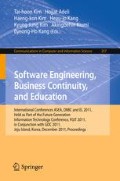Abstract
We show that recent Model-driven Engineering that uses sequential finite state models in combination with a common sense logic is subject to efficient model checking. To achieve this, we first provide a formal semantics of the models. Using this semantics and methods for modeling sequential programs we obtain small Kripke structures. When considering the logics, we need to extend this to handle external variables and the possibilities of those variables been affected at any time during the execution of the sequential finite state machine. Thus, we extend the construction of the Kripke structure to this case. As a proof of concept, we use a classical example of modeling a microwave behavior and producing the corresponding software directly from models. The construction of the Kripke structure has been implemented using flex, bison and C++, and properties are verified using NuSMV.
Access this chapter
Tax calculation will be finalised at checkout
Purchases are for personal use only
Preview
Unable to display preview. Download preview PDF.
References
Billington, D.: The Proof Algorithms of Plausible Logic form a Hierarchy. In: Zhang, S., Jarvis, R. (eds.) AI 2005. LNCS (LNAI), vol. 3809, pp. 796–799. Springer, Heidelberg (2005)
Billington, D., Estivill-Castro, V., Hexel, R., Rock, A.: Non-monotonic reasoning for requirements engineering. In: Proc. 5th Int. Conference on Evaluation of Novel Approaches to Software Engineering (ENASE), Athens, Greece, July 22-24, pp. 68–77. SciTePress — Science and Technology Publications, Portugal (2010)
Billington, D., Estivill-Castro, V., Hexel, R., Rock, A.: Modelling Behaviour Requirements for Automatic Interpretation, Simulation and Deployment. In: Ando, N., Balakirsky, S., Hemker, T., Reggiani, M., von Stryk, O. (eds.) SIMPAR 2010. LNCS, vol. 6472, pp. 204–216. Springer, Heidelberg (2010)
Billington, D., Rock, A.: Propositional plausible logic: Introduction and implementation. Studia Logica 67, 243–269 (2001) ISSN 1572-8730
Cimatti, A., Clarke, E., Giunchiglia, F., Roveri, M.: NuSMV: a new symbolic model checker. Int. J. on Software Tools for Technology Transfer 2 (2000)
Clarke, E.M., Emerson, E.A.: Design and Synthesis of Synchronization Skeletons using Branching Time Temporal Logic. In: Kozen, D. (ed.) Logic of Programs 1981. LNCS, vol. 131, pp. 52–71. Springer, Heidelberg (1982)
Clarke, E.M., Grumberg, O., Peled, D.: Model checking. MIT Press (2001)
Dromey, R.G., Powell, D.: Early requirements defect detection. TickIT Journal 4Q05, 3–13 (2005)
Estivill-Castro, V., Hexel, R.: Module interactions for model-driven engineering of complex behavior of autonomous robots. In: Dini, P. (ed.) ICSEA 6th Int. Conf. on Software Engineering Advances, Barcelona. IEEE (to appear, October 2011)
Manna, Z., Pnueli, A.: Temporal verification of reactive systems:Safety. Springer, Heidelberg (1995)
Mellor, S.J., Balcer, M.: Executable UML: A foundation for model-driven architecture. Addison-Wesley Publishing Co., Reading (2002)
Rock, A., Billington, D.: An implementation of propositional plausible logic. In: 23rd Australasian Computer Science Conference (ACSC 2000), January 31-February 3, pp. 204–210. IEEE Computer Society (2000)
Rock, A.: The DPL (decisive Plausible Logic) tool. Technical report (continually) (in preparation), www.cit.gu.edu.au/~arock/
Rumbaugh, J., Blaha, M.R., Lorensen, W., Eddy, F., Premerlani, W.: Object-Oriented Modelling and Design. Prentice-Hall, Inc., Englewood Cliffs (1991)
Schmidt, D.C.: Model-driven engineering. IEEE Computer 39(2) (2006)
Shlaer, S., Mellor, S.J.: Object lifecycles: modeling the world in states. Yourdon Press, Englewood Cliffs (1992)
Wagner, F., Schmuki, R., Wagner, T., Wolstenholme, P.: Modeling Software with Finite State Machines: A Practical Approach. CRC Press, NY (2006)
Author information
Authors and Affiliations
Editor information
Editors and Affiliations
Rights and permissions
Copyright information
© 2011 Springer-Verlag Berlin Heidelberg
About this paper
Cite this paper
Estivill-Castro, V., Rosenblueth, D.A. (2011). Model Checking of Transition-Labeled Finite-State Machines. In: Kim, Th., et al. Software Engineering, Business Continuity, and Education. ASEA 2011. Communications in Computer and Information Science, vol 257. Springer, Berlin, Heidelberg. https://doi.org/10.1007/978-3-642-27207-3_8
Download citation
DOI: https://doi.org/10.1007/978-3-642-27207-3_8
Publisher Name: Springer, Berlin, Heidelberg
Print ISBN: 978-3-642-27206-6
Online ISBN: 978-3-642-27207-3
eBook Packages: Computer ScienceComputer Science (R0)

